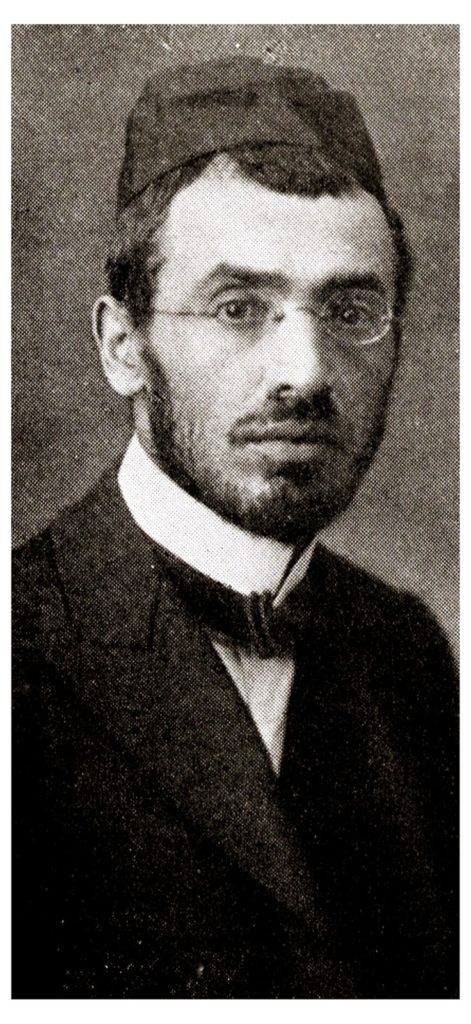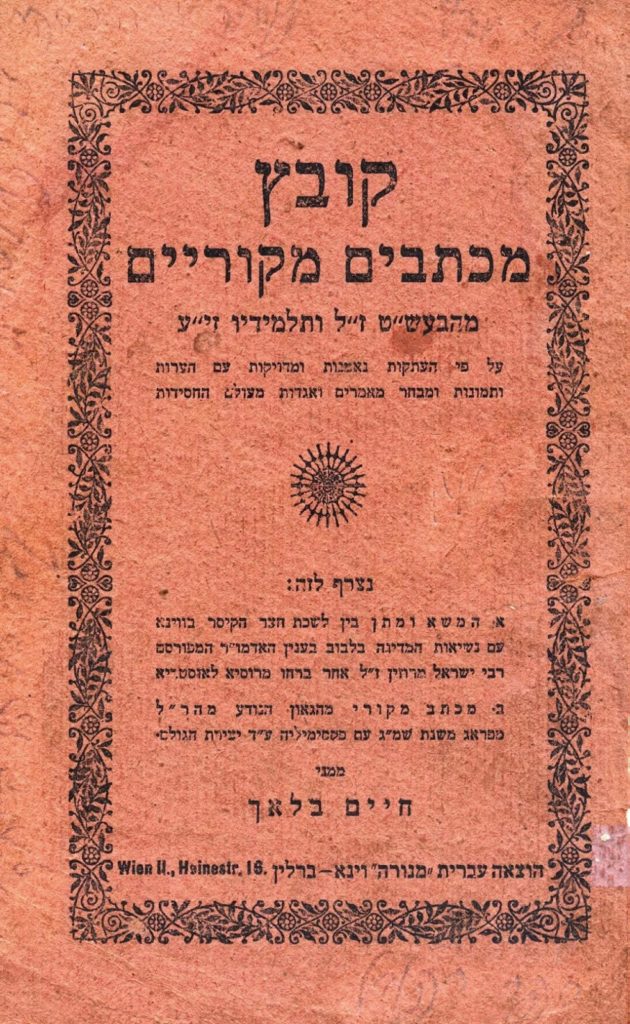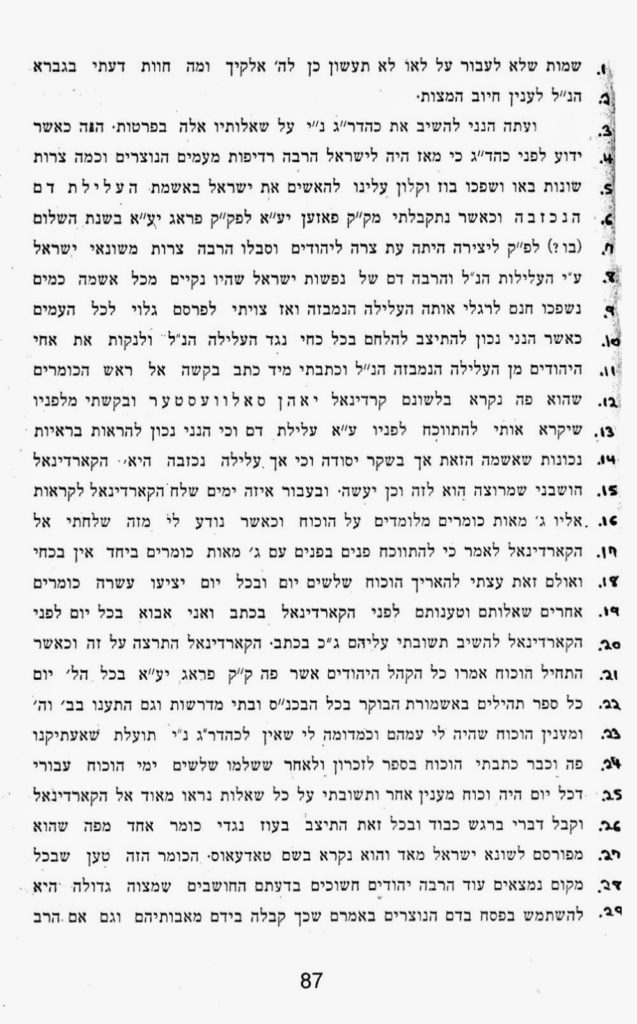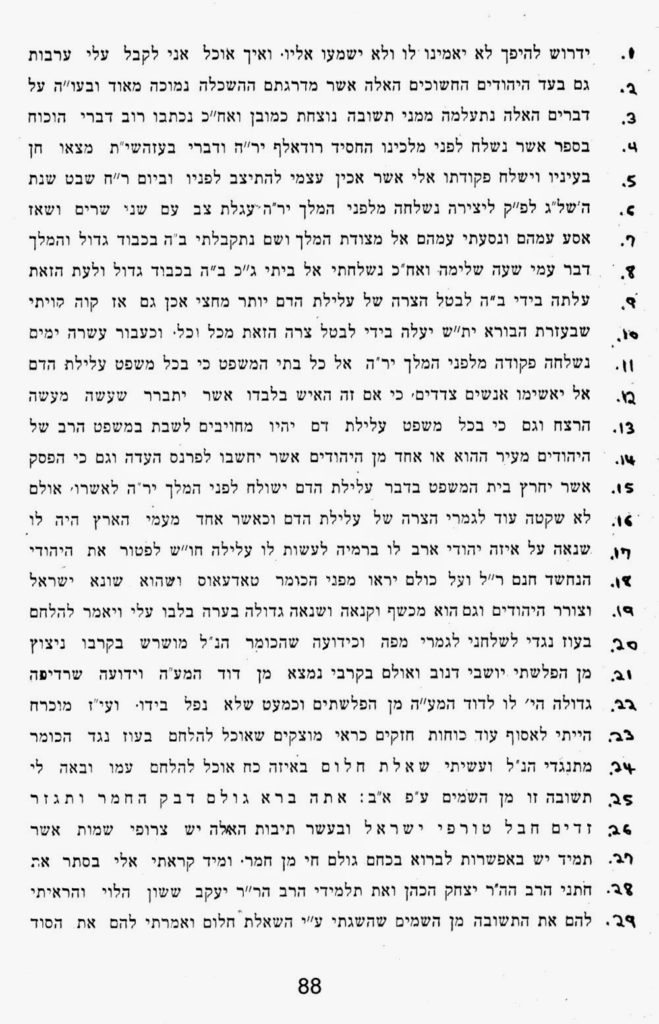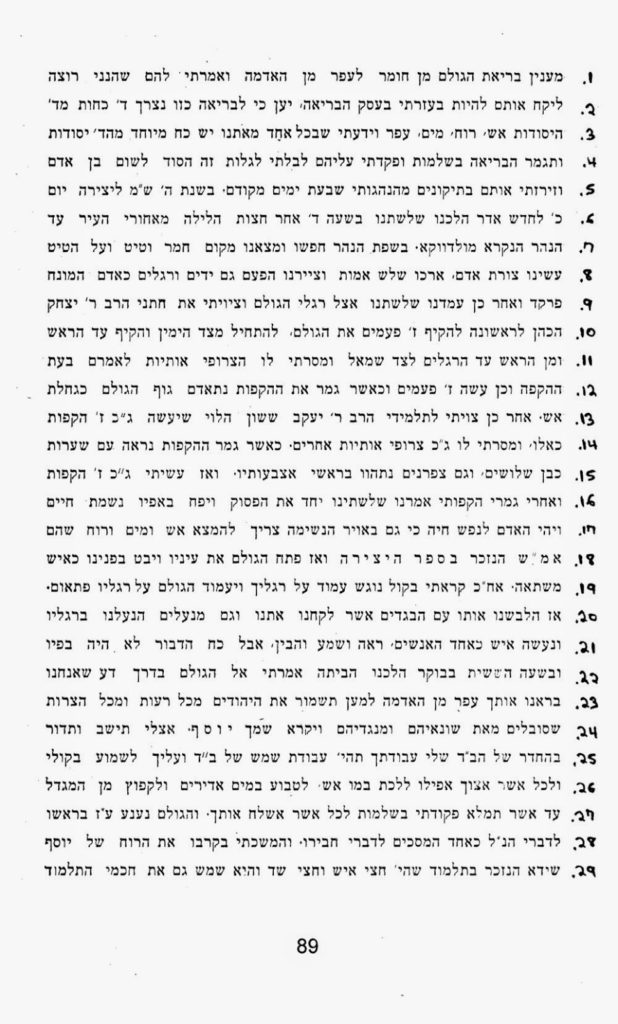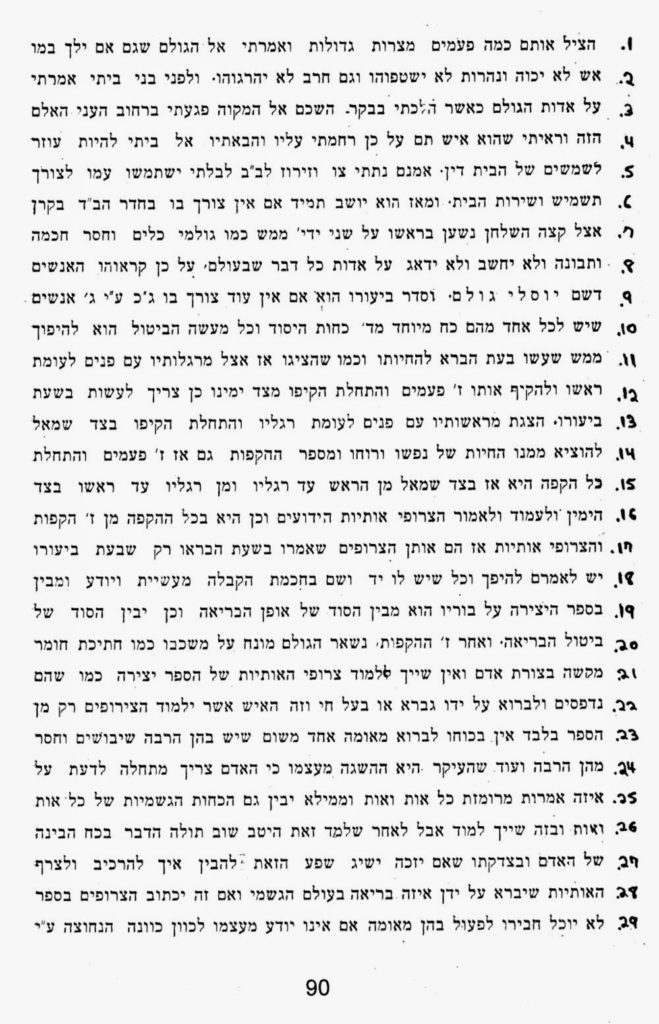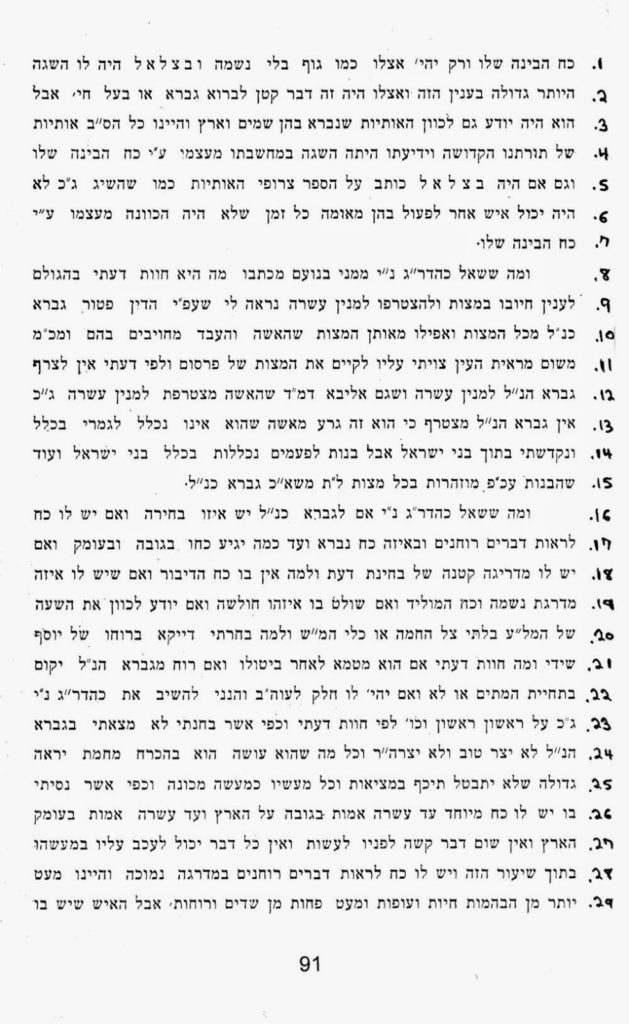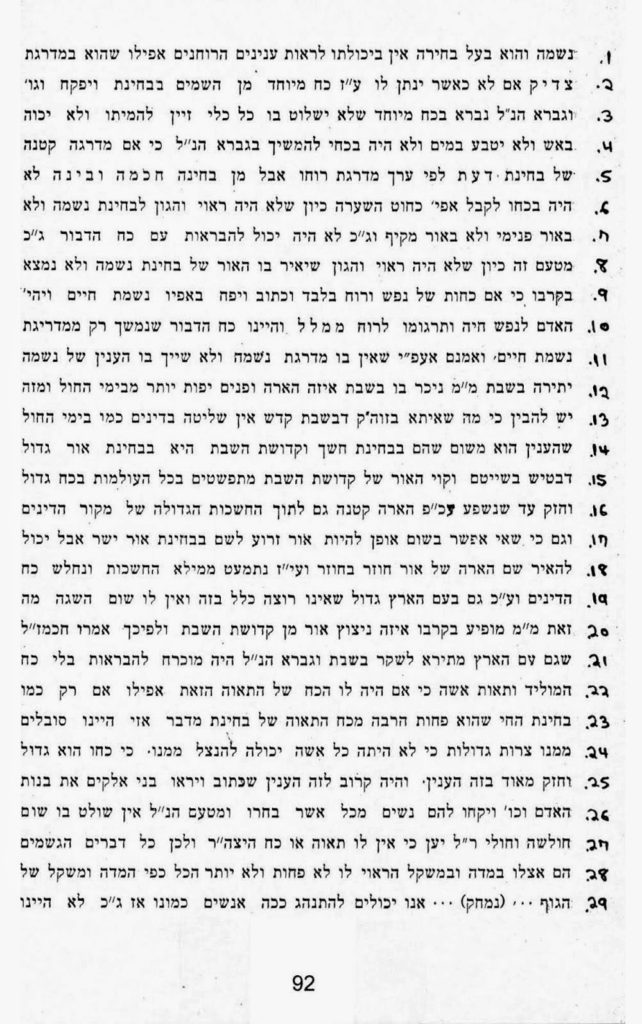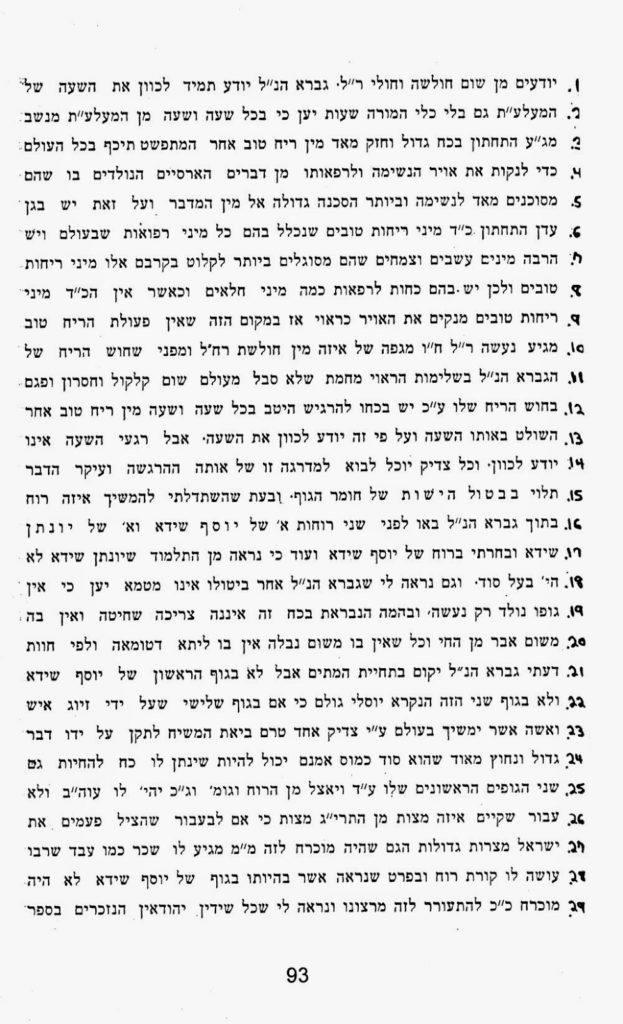The Golem of Prague in Recent Rabbinic Literature
by: Shnayer Leiman
In a recent issue of המאור – a rabbinic journal of repute – an anonymous notice appeared on the Golem of Prague.1 Apparently, a rabbi in Brooklyn had publicly denied the authenticity of the Maharal’s Golem, claiming that R. Yudel Rosenberg (d. 1935) – in his נפלאות מהר”ל (Piotrkow, 1909) – was the first to suggest that the Maharal had created a Golem. According to the account in המאור, the rabbi based his claim, in part, on the fact that no early Jewish book records that the Maharal had created a Golem. In response to the denial, the anonymous notice lists 6 “proofs” that the Maharal of Prague, in fact, created a Golem. Here, we list the 6 “proofs” in translation (in bold font) and briefly discuss the weight they should be accorded in the ongoing discussion of whether or not the Maharal created a Golem.
1. How could anyone imagine that a [Jewish] book written then [i.e., in the 16th century] could include a description of how Jews brought about the deaths of numerous Christians? At that time, the notorious censors censored even more fundamental Jewish teachings. Fear of the Christian authorities characterized every move the Jews made, from the youngest to the oldest.
The argument is presented as a justification for the lack of an early account of the Maharal and the Golem. Only in the 20th century could the full story appear in print, as it appears in נפלאות מהר”ל. Apparently, the author of the anonymous notice has never read נפלאות מהר”ל. The volume does not depict how “Jews brought about the deaths of numerous Christians.” If the reference here is to the punishment meted out by the Golem to the Christian perpetrators of the blood libel, נפלאות מהר”ל never depicts the Golem as bringing about the death of anyone, whether Christian or Jew. If the reference here is to the blood libel itself, נפלאות מהר”ל describes only how Christian criminals plotted against Jews (by means of the blood libel) and subsequently needed to be brought to justice by the Christians themselves. Nowhere are Jews described as bringing about the deaths of numerous Christians.
This argument, of course, does not prove that the Maharal created a Golem in the 16th century.
2. The Maharal’s creation of the Golem is alluded to on his epitaph, in the line that reads: “It is not possible to relate.” More proof than this in not necessary.
The full line on the epitaph reads as follows: “For him, praise best remains silent, for in any event it is not possible to relate the full impact of his many good deeds.”2 See Psalm 65:2 and cf. Rashi to b. Megillah 18a, ד”ה סמא דכולא משתוקא. Nothing is said – or hinted – here about a Golem. Alas, more proof than this is necessary indeed.
3. If this was an invention of the author of נפלאות מהר”ל, how come a storm was not raised up against him when he published his book a century ago? Although one solitary voice was raised up against him, the majority of Gedolei Yisrael greeted his book with esteem, especially since its author was the noted and respected Gaon, author of numerous works, Rabbi Yehudah Yudel Rosenberg.
First, it should be noted that R. Yudel Rosenberg did not invent the notion that the Maharal of Prague had created a Golem. Evidence for the Maharal’s Golem dates back to 1836 (before R. Yudel Rosenberg was born).3 If the rabbi in Brooklyn claimed otherwise, he was mistaken. Thus, the claim in 1909 that the Maharal of Prague had created a Golem occasioned little or no surprise.
Second, R. Yudel Rosenberg ascribed the book to R. Yitzchok b. R. Shimshon Katz, the son-in-law and contemporary of the Maharal. R. Yudel described in great detail how he had managed to come into possession of this rare manuscript.4 There was no immediate reason to suspect that this was a literary hoax, especially coming from the hand of R. Yudel Rosenberg.
Third, had the book contained pejorative material about the Maharal, a storm would surely have been raised against it. Instead, the book presented the Maharal as a master kabbalist, who created the Golem in order to stave off the notorious blood libel accusations against the Jews. Why should anyone have protested against this heroic image of the Maharal?
In any event, even if one concedes that “the majority of Gedolei Yisrael greeted his book with esteem” (a dubious claim that cannot be proven), it surely does not “prove” that the Maharal created a Golem. A book published in 1909 is hardly proof that the Maharal created a Golem in the 16th century.
4. Chabad Hasidim relate in detail how R. Yosef Yitzchok Schneersohn visited the attic of the Altneu shul in Prague and saw what he saw. He wasn’t the first to do so – as reported by various elders – in the last 400 years.
Indeed, a long list of the names of the famous and not-so-famous who visited the attic of the Altneu shul can easily be drawn up. That the sainted Rebbe, R. Yosef Yitzchok Schneersohn, visited the attic of the Altneu shul is established fact. It is recorded in contemporary documents, i.e, in the Sichos and Letters of his successor, the Rebbe, R. Menachem Mendel Schneerson.5 Exactly what the Rebbe saw in the attic is less certain. According to one account, when asked, R. Yosef Yitzchok chose not to respond.6 According to another account, he reported that he saw ”what remained of him,” i.e., of the Golem.7 For Lubavitchers, this may be unassailable proof that the Maharal created a Golem, and perhaps that is as it should be. But for historians, dust – or even a bodily form – seen in an attic early in the 20th century hardly constitutes proof that the Maharal created a Golem in the 16th century. As a matter of fact, it should be noted that extensive renovation took place in the attic of the Altneu shul in 1883. No evidence of the Golem was discovered then.8 A film crew visited and filmed the attic in 1984. No evidence of the Golem was discovered then.9
5. No one disputes the fact that the Maharal put an end to the blood libel accusations that the Jews had suffered for generations. And even this was not fully spelled out in the book [i.e., נפלאות מהר”ל]. Can someone explain how the Maharal accomplished this?
The rhetorical question at the end of the fifth “proof” presupposes the existence of the Golem. Only by means of the Golem was the Maharal able to counter the blood libel accusations. No one disputes that the Maharal put an end to the blood libel accusations? Quite the contrary, no one has ever discovered a shred of evidence that links the Maharal to staving off a blood libel accusation! Nowhere in his writings, nowhere in the writings of his contemporaries (Jewish and non-Jewish) and disciples, is there a word about the Maharal’s involvement in staving off a blood libel accusation. That he put an end to the blood libel accusation is historically untrue. While the blood libel charge became less frequent in the Hapsburg lands after the 16th century, it hardly disappeared.10 From the 16th through the 18th centuries, the blood libel accusation largely shifted to Eastern Europe. In Poland alone, between 1547 and 1787, there were 81 recorded cases of blood libel accusation against the Jews.11 The Beilis case is a sad reminder that the blood libel accusation continued into the 20th century as well.12
Needless to say, this argument hardly proves that the Maharal created a Golem in the 16th century.
6. I saw in מליצי אש to 18 Elul,13 a citation from a manuscript copy of a letter by the Maharal from the year 5343 [=1583] addressed to R. Yaakov Ginzburg, describing how he [the Maharal] was directed by Heaven to create a Golem in order to save the Jewish people. See there for details.
The manuscript referred to here is a notorious 20th century forgery of a letter ascribed to the Maharal, itself based upon R. Yudel Rosenberg’s נפלאות מהר”ל. The Munkatcher Rebbe, R. Hayyim Eleazar Shapira (d. 1937), apparently was the first of many to expose this forgery.14
II
In a subsequent issue of המאור, R. Hayyim Levi added 4 new “proofs” that the Maharal created a Golem.15 A brief summary of each of the new “proofs” is followed by an even briefer discussion of the weight they should be accorded in the ongoing discussion of whether or not the Maharal created a Golem.
1. The חיד”א in his שם הגדולים16 cites a responsum from the חכם צבי,17 who in turn cites a letter by R. Naftoli Ha-Kohen of Frankfurt,18 who mentions his ancestor the Maharal “who made use of the Holy Spirit.” The חיד”א adds that he heard an awesome story about the Maharal and a revelation he had which led to a private conversation between the Maharal and the King of Bohemia.
Not a word about the Golem of Prague appears in any of these sources. Indeed, where we can examine the available evidence (in the case of the awesome story heard by the חיד”א), it apparently had nothing to do with a Golem.19
2. R. Shimon of Zelikhov, משגיח of Yeshivat Hakhmei Lublin, said: “Everyone knows that the Maharal made use of the Sefer Yetzirah and created a Golem. I don’t claim that one needs to believe the tales in the storybooks about the Maharal. But it is clear that the Maharal used the book of Yetzirah and created a Golem.”20
R. Shimon of Zelikhov, a great gaon and zaddik, died as a martyr in 1943.21 His claim in the 20th century, however weighty, does not prove that the Maharal created a Golem in the 16th century.
3. In the book אלף כתב,22 the author writes that he heard from the Spinka Rebbe23 in 1922 that he saw an original letter of the Maharal that described how and why he created the Golem.
This is the same notorious 20th century forgery listed as a “proof” above, section I, §6. For the refutation of this proof, see the reference cited in note 14.
4. See סיפורים נחמדים,24 which records a story in the name of R. Yitzchok of Skvere25 about the Maharal, the Golem, and the double recitation of מזמור שיר ליום השבת at the קבלת שבת service.
This story, first published in 1837,26 is one of the oldest of the Maharal and the Golem stories. It was retold by R. Yitzchok of Skvere, and published in Yiddish (in 1890) and Hebrew (in 1903). Wonderful as the story may be, it cannot be adduced as “proof” for an alleged event that occurred some 300 years earlier.
—————————
Even aside from the dictates of rationalism, what militates against the notion that the Maharal created a Golem is the fact that nowhere in his voluminous writings is there any indication that he created one. More importantly, no contemporary of the Maharal – neither Jew nor Gentile in Prague – seems to have been aware that the Maharal created a Golem. Even when eulogized, whether in David Gans’ צמח דוד 27 or on his epitaph (see above), not a word is said about the creation of a Golem. No Hebrew work published in the 16th, 17th, and 18th centuries (even in Prague) is aware that the Maharal created a Golem.28
In this context, it is worth noting that R. Yedidiah Tiah Weil (1721-1805),29 a distinguished Talmudist who was born in Prague and resided there for many years – and who was a disciple of his father R. Nathaniel Weil (author of the קרבן נתנאל) and of R. Jonathan Eibeschuetz, both of them long time residents of Prague – makes no mention of the Maharal’s Golem.
R. Yedidiah Tiah Weil
R. Nathaniel Weil
This, despite the fact that he discusses golems in general, and offers proof that even “close to his time” golems existed. The proof is a listing of famous golems, such as the golems created by R. Avigdor Kara (d. 1439) of Prague30 and R. Eliyahu Ba’al Shem (d. 1583) of Chelm.31 Noticeably absent is any mention of the Golem of the Maharal of Prague.32
Note too that the first sustained biographical account of the Maharal – by a distinguished rabbinic scholar from Prague – was published in 1745.33 It knows nothing about a Golem of Prague. The deafening silence of the evidence from the 16th, 17th, and 18th centuries needs to be addressed by those who are persuaded that the Maharal created a Golem.
The cumulative yield of the “proofs” put forward in המאור in support of the claim that the Maharal created a Golem is perhaps best described as an embarrassment of poverty. In the light of what passes for historical “proof” in המאור, it would seem that המאור – a reputable rabbinic journal – would probably do well to focus more on halakhah and less on Jewish history.
III
Whereas המאור commemorated the 400th anniversary of the Maharal’s death by focusing on the imaginary accounts of the Maharal and the Golem, scholars in the Czech Republic are to be congratulated for commemorating the 400th anniversary by designing a magnificent exhibition of the Maharal’s life and works and displaying it at the Prague Castle. The exhibition was accompanied by an even more magnificent printed volume edited by Alexandr Putik and entitled Path of life (and referred to several times in the notes to this posting). Despite the many excellent studies in the book devoted to the Maharal’s life and thought, much space – some will argue too much space – is devoted to the history of the Golem in art, sculpture, film, and theater. In contrast to המאור, the essays in Path of Life assume that the Golem of Prague was legendary, not a fact. Here, we reproduce one of the many imaginary paintings of the Maharal and the Golem displayed at the exhibition and included in the volume. It was done by Karel Dvorak in 1951.33
Not to be outdone, the Czech post office issued a commemorative stamp to mark the 400th anniversary of the death of the Maharal. It features an imaginary portrait of the Maharal wearing a European casquette, reminiscent of the one the חפץ חיים used to wear in Radun. The first day cover includes an imaginary portrait of the Golem as well.
One wonders if the Maharal, prescient as he was, ever imagined that this is how he would be remembered on the 400th anniversary of his death!
Notes
1. Anonymous, “הילולא קדישא הארבע מאה של המהר”ל מפראג זי”ע: יצירת הגולם” Ha-Ma’or 62:4 (2009), p. 95.
2. The Hebrew original reads:
לו דומיה תהלה כי אין מספרים לרוב כח מעשי[ו] הישרים . See O. Muneles, כתובות מבית-העלמין היהודי העתיק בפראג, Jerusalem, 1988, p. 273. Cf. K. Lieben, גל עד, Prague, 1856, Hebrew section, p. 3.
3. See S. [the author asked that I not reveal his name], “
An Earlier Written Source for the Golem of the Maharal from 1836,” at On the Main Line, November 4, 2009. Cf. S. Leiman, “The Adventure of the Maharal of Prague in London,” Judaic Studies 3(2004), p. 20, n. 34; and see below, n. 32, for evidence from 1835 that may link the Maharal and the Golem.
4. נפלאות מהר”ל , Piotrkow, 1909, pp. 3-4.
5. See, e.g., R. Menachem Mendel Schneerson, תורת מנחם: התוועדויות, Brooklyn, 1992, vol. 1, p. 6.
6. See previous note.
7. Copy of a hand-written note by R. Menachem Mendel Schneerson published in the periodical כפר חב”ד, issue 798, 1998. The Hebrew reads in part:
בנוגע לעיקר הענין (שהמהר”ל עשה את הגולם), בעצמי שמעתי מכ”ק מו”ח אדמו”ר שראה הנשאר ממנו בעליית בית הכנסת דמהר”ל פראג.
The full text of the letter is also available online at
http://theantitzemach.blogspot.com, entry “
למה נקרא שמו ברוך דוב“, Tuesday, April 27, 2010, in a
comment by Anonymous posted on Wednesday, April 28, 2010 at 12:28 A.M. I am indebted to Zalman Alpert, reference librarian at the Mendel Gottesman Library of Yeshiva University, for calling my attention to the online version (and to many other important references over the many years we have known each other).
Yet a third account, drawn from a conversation with Rebbetzin Chana Gurary, a daughter of R. Yosef Yitzchok Schneersohn, provides even more detail. Rebbetzin Gurary reported:
I then asked him [her father, the Rebbe] to tell me what he had seen there. My father paused for a moment and said: “When I came up there, the room was filled with dust and shemus. In the center of the room I could see the form of a man wrapped up and covered. The body was lying on its side. I was very frightened by this sight. I looked around at some of the shemus that were there and left frightened by what I had seen.
Special thanks to Rabbi Shimon Deutsch for providing me with a copy of Rebbetzin Gurary’s testimony, as reported to Rabbi Berel Junik.
8. See N. Gruen, Der hohe Rabbi Loew, Prague, 1885, p. 39.
9. See I. Mackerle,
Tajemstvi prazskeho Golema, Prague, 1992. Cf. his “The Mystery of Prague’s Golem,” December 12, 2009, at
http://en.mackerle.cz.
10. See, e.g., R. Po-chia Hsia, The Myth of Ritual Murder, New Haven, 1988, pp. 203-209.
11. See Z. Guldon and J. Wijaczka, “The Accusation of Ritual Murder in Poland 1500-1800,” Polin 10(1997), pp. 99-140.
12. For basic bibliography on the Beilis case, See S. Leiman, “Benzion Katz: Mrs. Baba Bathra,” Tradition 42:4 (2009), pp. 51-52, n. 1.
13. Rabbi A. Stern, מליצי אש, Vranov, 1932. In the three volume Jerusalem, 1975 photomechanical reproduction of מליצי אש, the passage appears in vol. 2, p. 87.
15. R. Hayyim Levi, “המהר”ל זי”ע” Ha-Ma’or 63:1 (2009), p. 84.
16. R. Hayyim Yosef David Azulai (d. 1806), שם הגדולים השלם , Jerusalem, 1979, vol. 1, p. 124.
17. R. Zvi Ashkenazi (d. 1718), שו”ת חכם צבי, סימן ע”ו, ed. Jerusalem, 1998, pp. 183-4.
18. Loc. cit. R. Naftoli Ha-Kohen Katz of Frankfurt died in 1719. Cf. below, n. 32.
19. See Rabbi A.S. Michelson, שמן הטוב, Piotrkow, 1905, pp. 118-120.
20. R. Avraham Shimon of Zelikhov, נהרי א”ש, Jerusalem, 1993, p. 173.
21. See M. Wunder, מאורי גליציה, Jerusalem, 1978, vol. 1, cols. 238-243; Jerusalem, 2005, vol. 6, cols. 105-106.
22. Rabbi Y. Weiss (d. 1942), אלף כתב, Bnei Brak, 1997, vol. 2, pp. 47-48.
23. R. Yitzchok Eizik Weiss (d. 1944). On him, see T.Z. Rabinowicz, The Encyclopedia of Hasidism, London, 1996, pp. 534-5.
24. Y. W. Tzikernik, ספורים נחמדים, Zhitomir, 1903, pp. 13-14. Tzikernik’s hasidic tales were reissued by G. Nigal in סיפורי חסידות צירנוביל, Jerusalem, 1994. In Nigal’s edition, the story about the Maharal and the Golem appears on pp. 128-130. Tzikernik, who died circa 1908, was a follower of R. Yitzchok Twersky of Skvere (see next note) and recorded his stories for posterity.
25. On R. Yitzchok Twersky of Skvere (d. 1885), see Y. Alfasi, אנציקלופדיה לחסידות: אישים, Jerusalem, 2000, vol. 2, cols. 339-40.
26. The 1837 version appears in B. Auerbach, Spinoza, Stuttgart, 1837, vol. 2, pp. 2-3. See above, note 3, for a similar version of the story published in 1836. But the 1836 version makes no mention of the double recitation of מזמור שיר ליום השבת at the קבלת שבת service.
27. See David Gans, צמח דוד, Prague, 1592, entry for the year 5352 (= 1592). In M. Breuer’s edition (Jerusalem, 1983), the passage appears on pp. 145-6.
28. It is noteworthy that in 1615, Zalman Zvi Aufhausen, a Jew residing in Germany, published a defense of Judaism against a vicious attack by the apostate Samuel Brenz. In the introduction to his defense, Aufhausen writes that he was encouraged by the great Jewish scholars in Prague and Germany to undertake his defense of Judaism. In the list of accusations, Brenz accused the Jews of engaging in magical rites and creating golems out of clay. Aufhausen admitted that Jews created golems out of clay in the talmudic period (see b. Sanhedrin 65b), but only by means of Sefer Yetzirah and the Divine Name, and not by engaging in magical rites. After the talmudic period, according to Aufhausen, Jews no longer had the ability to create golems out of clay, especially in the German lands. Aufhausen concludes:
אביר אונזרי גולמיים אין דיזן לאנדן מכין מיר ניט אויש ליימן זונדר
אויש מוטר לייב ווערין זיא גיבורן.
In these lands, however, our Golems are not made from clay, but
rather they are born from the bodies of their mothers.
See Zalman Zvi Aufhausen, יודישר טירייאק [second edition], Altdorf, 1680, pp. 7a-b. Given the apologetic nature of Aufhausen’s defense, it is difficult to assess how much stock should be put in his claim. But, surely, if the Maharal’s Golem had been strolling the streets of Prague a decade or two earlier than the appearance of the first edition of Aufhausen’s work, he could hardly claim openly that Jews no longer had the ability the create Golems out of clay after the Talmudic period.
29. See L. Loewenstein, Nathaniel Weil Oberlandrabbiner in Karlsruhe und seine Familie, Frankfurt, 1898, pp. 23-85.
30. See the entry on him in Encyclopaedia Judaica, Jerusalem, 1971, vol. 10, cols. 758-759. In the 17th and 18th centuries, it was widely believed that he was the author of ספר הפליאה, a kabbalistic work that describes the creation of a Golem. Prof. Moshe Idel (in a private communication) suggests that this may have led to the belief that R. Avigdor Kara of Prague created a Golem. In any event, the fact that a distinguished Talmudist in 18th century Prague was persuaded that R. Avigdor Kara had created a Golem, suggests the possibility of a transfer in Prague of the Golem legend from R. Avigdor Kara (who by the end of the 18th century was relatively unknown) to the Maharal (who by the end of the 18th century resurfaced as a major Jewish figure whose works were being reprinted for the first time in almost 250 years). For other suggestions regarding the linkage between the Maharal and the Golem, see V. Sadek, “Stories of the Golem and their Relation to the Work of Rabbi Loew of Prague,” Judaica Bohemiae 23(1987), pp. 85-91; H. J. Kieval, “Pursuing the Golem of Prague: Jewish Culture and the Invention of a Tradition,” Modern Judaism 17(1997), pp. 1-23; Kieval’s updated version in his Languages of Community: The Jewish Experience in the Czech Lands, Berkeley, 2000, pp. 95-113; B. L. Sherwin, “The Golem of Prague and his Ancestors,” in A. Putik, ed., Path of Life: Rabbi Judah Loew ben Bezalel, Prague, 2009, pp. 273-291; and J. Davis, “The Legend of Maharal before the Golem,” Judaica Bohemiae 45(2009), pp. 41-59.
31. On R. Eliyahu Ba’al Shem of Chelm, see J. Guenzig, Die Wundermaenner in juedischen Volke, Antwerpen, 1921, pp. 24-26; G. Scholem, “The Idea of the Golem,” in his On the Kabbalah and its Symbolism, New York, 1969, pp. 199-204; M. Idel, “R. Eliyahu, the Master of the Name, in Helm,” in his Golem, Albany, 1990, pp. 207-212; and idem, גולם, Tel Aviv, 1996, pp. 181-184.
32. R. Yedidiah Tiah Weil, לבושי בדים, Jerusalem, 1988, p. 37. The passage comes from a sermon delivered in 1780.
Yet another 18th century witness, R. Saul Berlin (d. 1794), was apparently ignorant of the Maharal’s Golem. In his כתב יושר (written in 1784 but published posthumously in Berlin, 1794), p. 3b, Berlin writes:
ואולי דבר סרה על הנסים הידועים לכל בני הגולה, כאותם שעשה מוהר”ר לוי [קרי: ליוא] בהזמינו את הקיסר רודאלפוס למשתה, וע”י שם הוריד בירה מן השמים, או בגולם שעשה מוהר”ר נפתלי זצ”ל אשר עפרו עודנו טמון וגנוז.
Did [Wessely] speak disparagingly about the miracles known throughout the Jewish Diaspora? [Did he speak disparagingly] about those miracles performed by Rabbi Liva when he invited Emperor Rudolph to his party, and when by means of a Divine name he caused the Prague Castle to descend from heaven? Or regarding the Golem created by Rabbi Naftoli of blessed memory, whose dust still remains stored away?
Clearly, R. Saul Berlin knew legends about the Maharal. But when he needed to adduce a sample of the Golem legend, he had to turn elsewhere! Interestingly, the legend about the Prague Castle descending from heaven onto the Jewish quarter of Prague was first told about R. Adam Baal Shem, and not about the Maharal. It first appeared in print in Prague in the 17th century. By the 19th century, the very same story was told in Prague circles with the Maharal as its hero. Once again (see above, note 30) it would appear that we have a sample of the transfer in Prague of a legend from one hero to another, with the Maharal as the recipient. In general, see C. Shmeruk, ספרות יידש בפולין, Jerusalem, 1981, pp. 119-139.
Even more interesting is the reference to the Golem of R. Naftoli, otherwise unrecorded in Jewish literature. The reference is almost certainly to R. Naftoli Ha-Kohen Katz (1645-1719), distinguished halakhist and master of the practical kabbalah, whose amulets – apparently — didn’t always work. From 1690 to 1704 he served as Chief Rabbi of Posen. (Note too that the Maharal served as a Chief Rabbi of Posen!) Recorded in Jewish literature (though I have never seen it cited in any discussion of the Golem of Prague) is an oral tradition from 1835 that the Maharal’s Golem was created in Posen and that the remains of the Golem could still be seen in the 19th century in the old synagogue of Posen “under the eaves, lifeless, and inactive like a piece of clay.” See S. M. Gollancz, Biographical Sketches and Selected Verses, London, 1930, pp. v and 50-55, and especially p. 54. It is at least possible that R. Saul Berlin heard about the legend of the Golem of Posen and assumed (wrongly) that the Golem was created by the famed practical kabbalist and rabbi of Posen, R. Naftoli.
I am indebted to S. of the On the Main Line Blogspot (see above, note 3) for calling my attention to the כתב יושר passage.
Apparently, reports about the remains of Golems in attics were a rather widespread phenomenon in the early modern period. Aside from the reports about Prague and Posen, see the report about the Great Synagogue in Vilna (where the Vilna Gaon’s Golem rested in peace) in H.L. Gordon, The Maggid of Caro, New York, 1949, p. 176. A similar report about a Golem in Beshtian circles is recorded in R. Yosef of Tcherin, דרכי החיים, Piotrkow, 1884, Introduction, pp. 14-15.
33. R. Meir Perels (d. 1739), מגילת יוחסין , appended to R. Moshe Katz, מטה משה, Zolkiev, 1745. It was reissued separately in Warsaw, 1864, and is available in L. Honig, ed., חדושי אגדות מהר”ל מפראג, London, 1962, vol. 1, pp. 17-32. Perels’ מגילת יוחסין is riddled with inaccuracies and needs to be used with caution. See A. Putik and D. Polakovic, “Judah Loew ben Bezalel, called Maharal: A Study of His Genealogy and Biography,” in A. Putik, ed.,
Path of Life: Rabbi Judah ben Bezalel, Prague, 2009, pp. 29-83. Putik and Polakovic cite significant earlier studies by Y. Yudlov, D.N. Rotner, S. Sprecher, and others. See also N.A. Vekstein ‘s important analysis of Perels’ מגילת יוחסין, entitled “המהר”ל מפראג,” in המודיע, September 4, 2009.
In the light of the discussion in notes 30-33 — and until new evidence is forthcoming — it seems evident that the linkage between the Maharal and the Golem originated after 1780 and before 1835, almost certainly in Prague but perhaps in Posen.
34. See A. Putik, ed., Path of Life, pp. 398-399.
